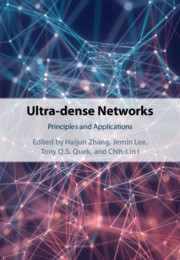1 - Ultra-dense Networks and Sliced Network Services
from Part I - Overview
Published online by Cambridge University Press: 12 October 2020
Summary
The network densification is one of the prominent solutions for fifth-generation (5G) networks to utilize spectrum resources through intensive deployment of small cells. However, the traffic management in dense networks become a serious challenge for underlying infrastructure supporting the virtual core network. Moreover, 5G will employ different types of communication frameworks: ultra-reliable low latency communication (URLLC), enhanced Mobile Broadband (eMBB), and massive Internet of Things (mIoT). Each identify standard slice type (STT) that have different performance requirements and enabling technologies. The current network developers do not provide any concise identification on how those logic networks would be administrated on top of physical network. This chapter investigates the 5G sliced networks and study virtual networking options to meet the performance requirements of service-based architecture.
Keywords
- Type
- Chapter
- Information
- Ultra-dense NetworksPrinciples and Applications, pp. 3 - 22Publisher: Cambridge University PressPrint publication year: 2020

